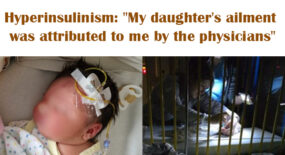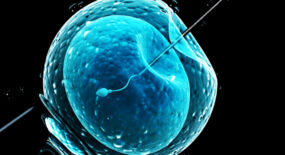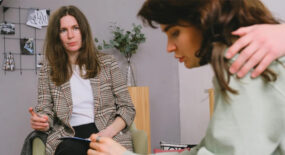Scroll down to find out just how low doctors said her chances of survival were
PROUD Natasha Sokunbi hugs her miracle baby – born while she was “d.e.a.d”.
Natasha’s h.e.a.r.t stopped for 14 minutes after she collapsed in an A&E waiting room when 37 weeks pregnant.

In a time crunch, a team of thirty quick-thinking medical professionals performed an emergency Caesarean s.e.c.t.i.o.n while simultaneously providing the mother with air and doing chest compressions.
Natasha then had to be put into a coma and did not meet her new daughter until three days after the delivery drama.
Yesterday, she told: “My heart wasn’t beating when the doctors delivered Beau. I was basically d.e.a.d when they pulled her out.
“The medical staff and physicians were outstanding. The things they have done for us are beyond words.

“As far as I’m aware, it’s pretty unheard of for both the mother and infant to survive in this situation,” stated Dr. Andrew Bennett, one of the first medical personnel on the site.
“It is testament to the speed of the response of everyone on our clinical teams, who were incredible.
We were lucky to deliver her in time, and she still had a pulse, although though the baby’s heart will stop a few minutes after the mother’s.
“To help her, staff members practically ran from the opposite side of the hospital. It truly was an amazing event.
Care support worker Natasha, 30, was around three weeks away from the due date for her second daughter when she called 111 for help with a chest i.n.f.e.c.t.i.o.n.
They told her to go to casualty and after a 25-minute taxi ride, she arrived at Royal Stoke Hospital at around 8am on December 3.

Five minutes after checking herself in at reception, she suffered a heart a.t.t.a.c.k.
She recalled: “The last thing I remember was walking through triage and I felt dizzy and c.o.l.l.a.p.s.e.d.
Then, when they performed the C-s.e.c.t.i.o.n and CPR, I was in and out of consciousness.
“I was so confused and I was in a lot of pain – it felt like somebody s.t.e.p.p.i.n.g on my chest.
“After that my next memory was hearing my husband and my sister talking next to my bed and I was trying to wake up but I couldn’t because I had been put into a coma.
“Please wake up,” my spouse was urging me. I was terrified to discover that I was not carrying a baby when I came around.

“They told me what had happened but I couldn’t believe it until my husband showed me a photo and told me it was a girl.
“I felt so guilty because I had fallen straight on to my stomach and I thought I’d hurt the baby.”
“I was afraid my h.e.a.r.t was going to stop again when I was in the hospital,” Natasha continued. For three days, I was unable to sleep because I was terrified that I wouldn’t wake up and would never see my kids again.
Together with her other daughter, 16-month-old Love, and husband, 29-year-old Ayo, mother and baby Beau, now two months old, returned home in Stafford in time for Christmas.
Natasha has had a defibrillator fitted to combat a genetic heart condition that she had been treated for in the past but had believed to be under control.
“I knew getting pregnant was a danger, but when I checked in with my cardiologist, everything was perfect – the pregnancy was progressing incredibly well,” she continued.

Dr Bennett, 34, said: “Natasha is phenomenally lucky that she came to A&E. If it had happened anywhere else, the outcome would have been quite different.
Seeing so many people collaborate so swiftly and provide exceptional care was both one of the worst things I have ever witnessed and one of my best professional moments.
According to reports, this is a once-in-a-lifetime opportunity for an emergency physician. I was thrilled to learn that Natasha and her family had been released from the hospital and had arrived home in time for Christmas, and my thoughts and prayers are with them.
Natasha, originally from the Welsh Valleys, went on: “I am taking it day by day and had to learn to walk again but we are both much better now.
“Being a mum of two is great and I’m regaining my strength and independence.
“Now I’m much more appreciative of life and won’t take anything for granted ever again.” The life-saving procedure Natasha had is called a resuscitative hysterotomy.

Hospital staff usually perform cardiopulmonary resuscitation (CPR) using a mask to push air into the patient’s lungs and a combination of defibrillator zaps and chest compressions.
A study last year estimated that the chance of both mother and baby surviving the procedure could be as low as 4.5 per cent.
Dr Bennett was not involved with the study but told: “It seems as though the baby only tends to survive when the cardiac arrest happens in hospital – it makes a big difference.
Because of all the activity, doing anything while CPR is being administered becomes increasingly challenging.
“The mother’s survival is the priority but being pregnant can make resuscitation more difficult so getting the baby out, if it is the right age, quite quickly becomes an equal factor.
As urgent as a C-section can get, this is.
“And then you go from having one patient who needs resuscitation to possibly having two who need it at the same time, so you need a huge number of clinical teams.”

Dozens of staff from at least five departments were drafted in to pull it off, many of them just about to clock off after a night shift.
Since then, University Hospitals of the North Midlands NHS Trust has given the Chief Executive Award to the brave medical professionals involved.










